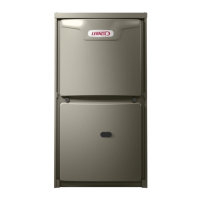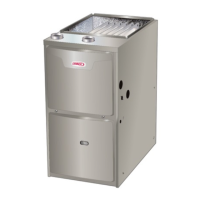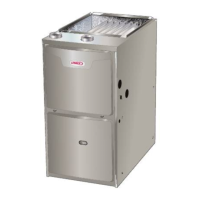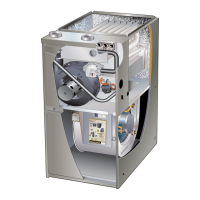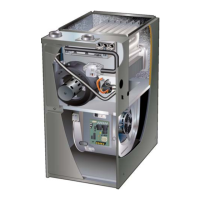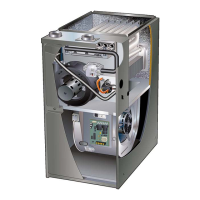Page 44
V-TYPICAL OPERATING CHARACTERISTICS
A-Blower Operation and Adjustment1
NOTE- The following is a generalized procedure and
does not apply to all thermostat controls.
1 - Blower operation is dependent on thermostat control
system.
2 - Generally, blower operation is set at thermostat sub
base fan switch. With fan switch in ON position, blower
operates continuously. With fan switch in AUTO position,
blower cycles with demand or runs continuously while
heating or cooling circuit cycles.
3 - Depending on the type of indoor thermostat, blower
and entire unit will be off when the system switch is in
OFF position.
B-Temperature Rise (Figure 54)
Temperature rise for ML196UH units depends on unit in
put, blower speed, blower horsepower and static pressure
as marked on the unit rating plate. The blower speed must
be set for unit operation within the range of “TEMP. RISE
°F” listed on the unit rating plate.
FIGURE 54
Return
Supply
High “+”
Low “-”
+
−
or
EXTERNAL STATIC PRESSURE
Supply Duct Static
Return Duct Static +
Total Duct Static =
(dry coil)
C-External Static Pressure
1 - Tap locations shown in figure 55.
2 - Punch a 1/4” diameter hole in supply and return air ple
nums. Insert manometer hose flush with inside edge of
hole or insulation. Seal around the hose with perma
gum. Connect the zero end of the manometer to the
discharge (supply) side of the system. On ducted sys
tems, connect the other end of manometer to the return
duct as above.
3 - With only the blower motor running and the evaporator
coil dry, observe the manometer reading. Adjust blow
er motor speed to deliver the air desired according to
the job requirements. For heating speed external static
pressure drop must not be more than 0.5” W.C. For
cooling speed external static pressure drop must not
be more than 0.8” W.C.
4 - Seal the hole when the check is complete.
FIGURE 56
Return
Supply
TEMPERATURE RISE
Supply Duct Temperature
Return Duct Temperature
_
Temperature Rise =
D-Blower Speed Taps
Blower speed tap changes are made on the integrated con
trol. See figure 3. The heating tap is connected to the
“HEAT” terminal and the cooling tap is connected to the
“COOL” terminal. On all units the continuous blower tap is
connected to the “FAN” terminal. Unused taps must be se
cured on two dummy terminals labeled ”PARK. To change
out existing speed tap, turn off power and switch out speed
tap with tap connected to “PARK”. See blower speed tap
table on unit diagram for motor tap colors for each speed.
